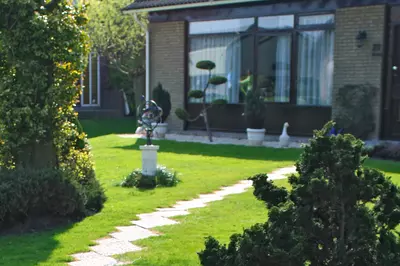How You Can Create a Healing Environment at Home

To begin, follow one simple guideline: look for ways to reduce stress!
Below are some ways to do that.
1. Go for comfort
We humans all have a strong need for safety and security and look for those attributes in our environment. We also look for physical comfort, such as an environment with the right temperature, and psychological comfort, where there is a mix of familiarity and stimulus. So consider how you might boost your comfort level!
- Increase your sense of security by doing an audit of your home, perhaps with information or help from your police department.
- To enhance home safety, read Create a safe home.
- Evaluate the physical comfort of your home—your furniture, floors, and temperature to name a few. You might be able make it more cozy with simple changes, like a small carpet by the bed, or decide to start saving for larger items, like more comfortable chairs.
- Consider how you might add some novelty or interest to your home for a little stimulus.
2. Cut the clutter
Visual “noise” increases stress. A cluttered, dirty, or confusing environment can cause us to feel worried, sad, or helpless.
Start with one small area. Clear a counter, de-clutter a shelf, or organize a drawer. This will give you a sense of success to help you proceed—and give you a place to look at when the chaos elsewhere is discouraging. Keep that area free from clutter from now on—and build on it by tackling one additional area at a time.
3. Delight your senses
- Choose colors that you find appealing for your walls and furniture.
- Place photos and objects with special meaning to you where you see them often.
- Add artwork you like or an aquarium
- If you like the sound, add a water element.
Consider getting a diffuser or vaporizer to disperse essential oils that you find appealing.
4. Enhance the light
Daylighting, that is natural light, is associated with improved mood, enhanced morale, lower fatigue, and reduced eyestrain. So take advantage of any natural light you have. Then supplement it with a variety of light sources, such as a floor lamp
5. Bring nature in
Studies show that even a short contact with nature can significantly reduce stress, reduce anger and fear, and increase pleasant feelings. So if you have views of trees or other plants or natural elements, place a comfortable chair where you can enjoy them. You can also add indoor plants, aquariums, or art with a nature theme and get much of the same effect.
6. Reduce the roar
Work with these simple suggestions:
- Be mindful about your personal noise production. For example, are you really watching your television, or is it simply on as "background noise?" Could you use a push mower instead of a power model? Select "vibrate" rather than the latest ringtone? Even small actions increase the peace.
- Plant trees, especially evergreens, as a noise screen.
- Try playing recordings of natural sounds, such as water or birds, to mask urban noise that causes stress.
7. Don’t forget the garden
Research point to the many benefits of having a garden, and the closer it is to your house and the more you visit it, the more positive effect on stress. Gardening is also good exercise!
8. Start small
One way to start is to choose a room or corner that you can make into a healing space. If you already have a favorite place that you can use, wonderful. If it has good natural light and a view of the outdoors, even better.
Then consider what activities you find most healing and adapt the space to them. Do you love to read? Move a comfortable chair and good light into the space. Do you meditate? Perhaps a water fountain would help you relax and focus. You might even find that your healing space is a workbench where you build or fix things, and organizing your tools and providing good light is what you need.
9. Consider your inner environment
Along with your physical space, consider your inner environment as well. Realize that optimism, hardiness, self-efficacy, and a sense of control are linked to good health and that they can be learned and practiced. Set a positive intention for your interactions at home!
Bowler, D. E., Buyung-Ali, L. M., Knight, T. M., & Pullin, A. S. (2010). A systematic review of evidence for the added benefits to health of exposure to natural environments. BMC Public Health, 10, 456.
Clark, C., Sörqvist, P. (2012). A 3 year update on the influence of noise on performance and behavior. Noise Health;14(61), 292-6.
Edwards, L., and Paul A. Torcellini. (2002). A literature review of the effects of natural light on building occupants. Golden, CO: National Renewable Energy Laboratory.
Huelat, Barbara (2003). Healing Environments: Design For the Body, Mind & Spirit. Alexandria and Arlington, VA: Medezyn and Peecapress.
Huelat, Barbara (2007). Healing Environments: What's the Proof? Alexandria and Arlington, VA: Medezyn and Peecapress.
Hyder, C. (1998). Wind and Water: Your Personal Feng Shei Journey. Berkeley, CA: The Crossing Press
Küller, R. and Küller, M. (2001) The influence of daylight and artificial light on diurnal and seasonal variations in humans. A bibliography. Vienna: CIE Technical Report No. 139, Commission International de l'Eclairag.
Marcus, C., and Barnes, M. (1999). Healing Gardens. New York, NY: John Wiley and Sons.
Selub, E., Logan, A. (2012). Your brain on nature. Mississauga, Ontario: Wiley.
Sternberg, E. M. (2009). Healing spaces. Harvard University Press.
Stigsdotter, U., Grahn, P. (2004). A Garden at Your Doorstep May Reduce Stress – Private Gardens as Restorative Environments in the City. Department of Landscape Planning, Alnarp Swedish University of Agricultural Sciences SLU.


